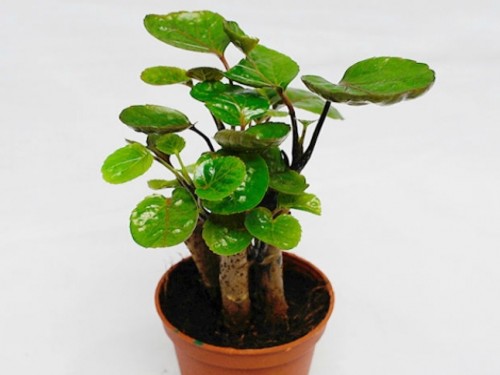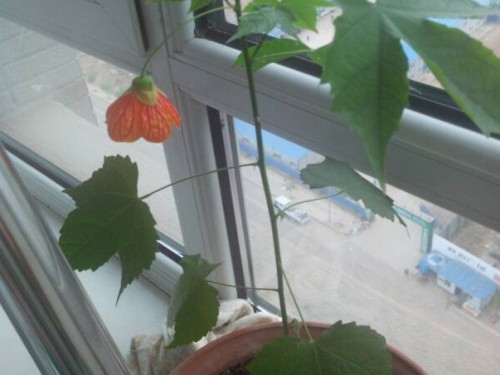Culture method of potted round-leaf tree
Fulutong is a popular indoor high-grade evergreen foliage plant in recent years, also known as money pocket, a lot of money. Its plant shape is elegant, Ye Zi amorous feelings, and then because of its implication of wealth and auspiciousness, "the family has Fulutong, wealth is more prosperous", it has become a very popular Spring Festival plant.

Round-leaf Fulutong, also known as round-leaf Nanyangsen, round-leaf Nanyang ginseng, is an evergreen shrub or small tree of Araliaceae and Nanyang forest. The plant is multi-branched and the stem is grayish brown and covered with lenticels. Branches soft, leaves alternate, 3-foliolate pinnately compound or simple, leaflets broadly ovate or suborbicular, base cordate, margin serrulate, leaves green. Usually less branched, stem surface densely covered with obvious lenticels. Umbels paniculate.
Let's take Fulutong as an example to take a look at the specific maintenance methods.
1. Soil
Loose and fertile sandy loam with good drainage is the best to provide it with a loose, moist and fertile soil environment. In general, the soil is changed every two years in the spring. For fertilization, the mixture of 0.2% urea and 0.1% potassium dihydrogen phosphate can be irrigated in the family pot plant, or a small amount of multi-component slow-release compound fertilizer particles can be sprinkled or buried on the surface of the pot soil. Pay attention to the balance of nitrogen, phosphorus and potassium when fertilizing. If a disease occurs, the diseased leaves should be removed and destroyed in time.
2. Lighting
Need bright light, lack of light can easily cause long stems and leaves, dim leaves, faded markings, but at the same time avoid strong light exposure, especially after a long rain in early summer, to prevent leaves from being burned. Family potted plants can be placed in a well-ventilated place near the south entrance, north or east windows in summer, and indoor light in winter. In short, it grows most vigorously in an environment with half-light and bright scattered light.
3. Temperature
The near temperature of growth is 15: 30 ℃, of which it can be maintained at 20: 30 ℃ from April to October and at 13: 20 ℃ from October to April of the following year. In general, the room temperature should be maintained at no less than 10 ℃ in winter. In late autumn and early winter, when the temperature drops to 15 ℃, it should be moved indoors in time to avoid cold damage. If the room temperature can be maintained more than 20 ℃ in winter, the stems and leaves will continue to grow; if the temperature is not high, the plant will stop growing and enter a semi-dormant state. In short, the room temperature should be maintained at no less than 10 ℃ in winter. When the summer temperature is more than 32 ℃, we can't let it go.
4. Humidity
During the growing period, Flutong kept the basin soil moist without stagnant water, and often sprayed the plant with water close to room temperature to increase air humidity and make the leaf color fresh.
5. Moisture
Potted Fulutong likes wetter soil and air environment. During the growing period, there should be sufficient water supply, and then watering the surface of the basin soil after drying, the soil should be slightly dry, but it should not be watered too much to avoid causing stagnant water and rotting roots. The temperature is high in midsummer, in addition to sufficient watering, it is necessary to spray water on the leaf surface once a day, which can not only make the leaf surface clean and bright, but also improve the air humidity around the plant. In late autumn and early winter, when the temperature drops below 15 ℃, watering should be controlled. In winter, the amount of boiling water should be reduced, or water spraying should be used instead of watering, and the basin soil should be kept slightly moist and slightly dry, but when spraying foliage, we should pay attention to make the water temperature basically consistent with room temperature.
Time: 2019-06-01 Click:
- Prev

How to raise miniature coconuts in potted plants
Pocket coconut is a small evergreen shrub native to Mexico and Central America. It is generally about 20-30 cm high and the taller species can reach up to 1 meter. Family farming is generally small pocket coconuts, placed in desks, living rooms, balconies and other places. Let's briefly talk about how to raise pocket coconuts.
- Next

Culture method of potted Platanus orientalis
Platanus orientalis, alias golden bell, bluebell, gorilla, lantern, palace lantern, chandelier, is an evergreen shrub of the genus Malvaceae, up to 1 meter high. Flowering is particularly drooping, bell-shaped, orange-yellow, with bright purplish red veins, stamens and style longer, protruding beyond the Corolla
Related
- Fuxing push coffee new agricultural production and marketing class: lack of small-scale processing plants
- Jujube rice field leisure farm deep ploughing Yilan for five years to create a space for organic food and play
- Nongyu Farm-A trial of organic papaya for brave women with advanced technology
- Four points for attention in the prevention and control of diseases and insect pests of edible fungi
- How to add nutrient solution to Edible Fungi
- Is there any good way to control edible fungus mites?
- Open Inoculation Technology of Edible Fungi
- Is there any clever way to use fertilizer for edible fungus in winter?
- What agents are used to kill the pathogens of edible fungi in the mushroom shed?
- Rapid drying of Edible Fungi

